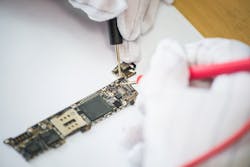Qualcomm announced a new line of audio SoCs aimed at customers adding voice control interfaces to smart speakers, soundbars and other wireless audio devices. The San Diego, California-based company's chips are designed to distinguish voice commands in louder environments and over longer distances than its previous generation of audio products without sacrificing sound quality.
The QCS400 SoCs have higher performance and lower power than its previous audio product line, according to Rob Saunders, product marketing manager at Qualcomm. Based on the 28-nanometer node, the chips are designed to reduce development time and cost for devices that can be controlled through a person's voice, he said. Use cases range from cheaper smart speakers to premium soundbars.
"The chip has the highest level of integration and highest level of performance we have ever put into an audio SoC," Saunders told Electronic Design. The chips consume up to 25 times less standby power than its last generation of wireless audio chips. That enables battery-powered devices, such as portable smart speakers, to listen for keywords and other voice commands for longer periods of time between charges.
Qualcomm's chips can connect to other devices using WiFi, Zigbee or Bluetooth, giving any smart speaker or soundbar the ability to act as the control center for smart household devices, such as light bulbs or door locks. They also support Qualcomm's AptX technology for low-latency wireless audio distribution over WiFi or Bluetooth. That makes it possible to network multiple smart speakers around a single room or house.
The chips feature up to four Cortex-A53 CPU cores and up to 32 channels of integrated audio processing. Every chip also contains dual DSP cores based on Qualcomm's Hexagon technology. One of the cores is devoted to advanced audio processing while the other is for handling voice commands and other artificial intelligence chores. They can be programmed to respond to words and phrases other than the standard “Alexa" or “Hey, Google.”
QCS400 SoCs can handle automatic speech recognition and pick up multiple keywords without sending voice commands to the cloud for processing. That lowers latency, leading to faster response times and more accurate voice detection in loud environments. Running these artificial intelligence tasks inside the device also makes it possible for core voice control capabilities to work even without an internet connection.
The chips can handle advanced audio algorithms to support echo cancellation and far-field voice processing. They can also handle concurrent phrase and keyword spotting so that customers can program devices to, for instance, flick on connected light bulbs not only when someone says "Turn on the lights" but also when they say "It's dark in here." Other players in the voice control chip market include Synaptics, Syntiant and Knowles, among others.
"Being able to deliver voice interface technology in an integrated solution and at lower power - so we can enable that experience much more broadly - is very important for us," Saunders told Electronic Design. "We did not hold back on the level of audio processing we can offer customers. And connectivity is part and parcel with audio capabilities when you have to implement audio wirelessly."
About the Author
James Morra
Senior Editor
James Morra is the senior editor for Electronic Design, covering the semiconductor industry and new technology trends, with a focus on power electronics and power management. He also reports on the business behind electrical engineering, including the electronics supply chain. He joined Electronic Design in 2015 and is based in Chicago, Illinois.

